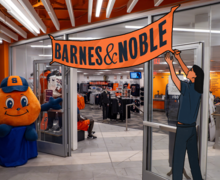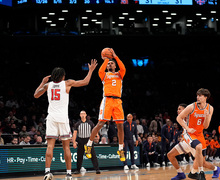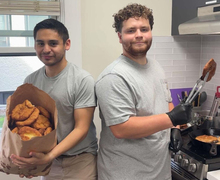DPS adds van to late-night escort service
Sara Benazzi had just pulled an all-nighter during finals week and needed a textbook from her apartment.
She didn’t want to walk there alone at 6 a.m. from E.S. Bird Library, so she called the Department of Public Safety and requested an escort.
But after waiting 30 minutes, Benazzi called DPS back and told them she was walking.
‘I felt uncomfortable walking by myself at the crack of dawn — and still nothing,’ said Benazzi, a senior history and economics major.
Though Benazzi didn’t take the escort, many students did, as combined DPS services provided 22,268 escorts in the previous academic year. To alleviate demand, the department has made a pilot shuttle van permanent this year.
DPS also began advertising its 711 mobile system to students for the first time, getting the word out about the option to call or text DPS in an emergency.
The now permanent six-person night shuttle, known as Shuttle 44, has helped DPS pick up the slack on walking escorts, said DPS Capt. John Sardino.
Unlike the Shuttle-U-Home van, which only takes students from Watson Hall to off-campus locations, Shuttle 44 picks up students from their calling location if they’re in the immediate campus area, such as the East neighborhood.
But the shuttle is primarily for students returning home from academic work or those needing to reach another side of campus, Sardino said.
‘We’re going to avoid taking a student from one social spot to another,’ he said.
The shuttle runs from 11 p.m. to 3 a.m. Sunday through Tuesday and 11 p.m. to 6 a.m. Wednesday through Saturday.
The response times for all escorts — walking or van — depend on whether students are in a safe place or out in the open, where there’s potential danger, Sardino said. Students typically wait an average of 10-12 minutes, but they could wait 30 minutes if officers are busy, he said.
‘If you’re calling from your resident hall and you’re in a safe environment, you might have to wait a little bit longer if we’re tied up,’ he said.
But some students question why officers can’t be quicker late at night.
‘A lot of the time, they’re just parked in a parking lot, talking to each other,’ said Maria Rein, a senior geography and international relations major.
Rein had waited up to 30 minutes for an escort before. But she said the response time and willingness to give an escort depended on which officer she talked to.
Lauren Krauth used to take DPS escorts between South Campus and Main Campus, sometimes waiting 30 minutes for the escort, she said.
‘I feel like, a lot of times, they think you’re just using them because it’s cold out and you don’t want to walk,’ said Krauth, a senior international relations major.
For students in actual emergencies, DPS is actively promoting a text system originally designed for students held in hostage situations in classrooms that is now being used for emergencies around campus.
Students can text 711@syr.edu in an emergency, and the message will go to an e-mail account at DPS to alert the dispatcher.
But DPS doesn’t want to see students use the text system as the primary means to contact officers, said Mike Kearns, manager of technical services at DPS.
‘When you call for help, you really need a two-way conversation,’ he said. ‘So we look at this as a backup communication method with Public Safety.’
DPS felt it was finally time to advertise the system, which is a year and a half old, after working out some bugs and glitches, Kearns said.
So far, only faculty with communication limitations, such as speaking or hearing impediments, have used the text system, he said.
One SU physical plant worker, who got stuck in an elevator and couldn’t speak, texted the number once, and DPS responded and got him out, Kearns said.
But if students don’t text their locations in the message — which is limited to 160 characters on some phones — it would be difficult for DPS to find them, Kearns said.
Regardless of the text system, some students could still call in emergencies.
‘I feel like calling is just as easy, but if they don’t feel comfortable to call, they can text,’ said Melissa Rothstein, a senior psychology and neuroscience major.
Rothstein said she would call if she was in an emergency because it’s faster.
But the text system may be good for students if they’re trying to reach DPS in a big crowd at a party, said Perry Russom, a sophomore political science and broadcast journalism major.
‘It’s a good option,’ he said. ‘But I don’t think it’s an end-all.’
The text system shows DPS is at least staying ahead with technology, Russom said.
He joked, ‘I guess the next thing is an app on your iPhone for DPS.’
Published on September 14, 2010 at 12:00 pm





